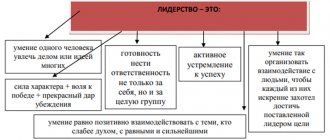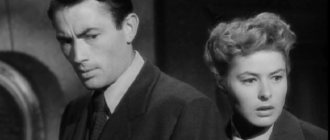In any team, a leader appears. But who is this and where does he come from? Why does one become a leader and others follow him? What character traits and skills define a leader and help him stand out from the rest? Is it possible to become a leader of your own accord? What techniques help with this? Should we strive for championship, maybe it would be better to be like everyone else? What difficulties do those who decide to lead a team face? Are they commensurate with the advantages that open up to a person? There are many questions, but we will try to find answers to them.
Introduction
The success of any organization is directly related to the nature of leadership, the relationships that develop between managers and subordinates.
One of the key problems in management psychology is the problem of leadership and management. Leadership is a critical component of effective leadership. A leader is a symbol of community and a model of group behavior. Leadership effectiveness is directly related to the ability of leaders to manage organizational and interpersonal communication, influencing its nature.
Since leadership contains additional opportunities to increase the efficiency of organization management, the practical task of selecting individuals for leadership with the qualities of a leader or training in leadership behavior is relevant. The leader must claim businesslike, official leadership in the group, informal recognition of his competence, approval, and trust of group members.
The choice of certain methods of influence is made by the manager based on an analysis of a specific situation. In addition to the objective conditions of the situation, this choice is also influenced by the psychological characteristics of the leader. They define a set of methods systematically used by managers for making decisions, influencing subordinates, communicating with them, i.e. leadership style. Each manager has his own unique leadership style. At the same time, there is a certain commonality in the styles of different managers.
The work examines leadership styles and makes an attempt to identify the positive and negative features of each style.
Two types of leadership
Leadership ability is the most important factor in the success or failure of any business. A leader always makes himself. Leaders continually work to develop their skills and become stronger.
There are two types of leaders:
1) The first type of leader is a transformational leader or transformative leader.
This leader is a trailblazer, a dreamer and a visionary. These leadership qualities motivate and inspire people to act far beyond the level at which they previously acted.
2) The second type of leader - transactional leader or implementation leader - is the most important and fundamental. An implementer leader achieves results by organizing the work of other people.
True leaders use their personality and core traits to motivate, inspire, and build high-performing teams.
Leader and leadership - concept, classification
Leadership is the process of social organization and management of communication and activities of group members, carried out by a subject (leader) endowed with a certain power [5].
24 pages, 11558 words
Leadership theories. The role of the leader in managing an organization
...possible and appropriate, leadership. Destructive leaders, for example, leaders of groups of opponents of innovations, drinking buddies... decisions, can cause great damage to personnel management and the activities of the organization as a whole. 3. Management of leadership in an organization The primary importance of leadership for the effectiveness of management, its positive and negative impact on personnel management is given ...
The word leader comes from the English lead (to lead).
This means that a leader is one who leads the way.
A leader is a member of an organization who has a high personal status, has a strong influence on the opinions and behavior of the people around him, members of any association or organization, and performs a set of functions [5].
Practice shows that no single factor provides greater benefits and benefits for an organization than effective leadership. Leaders are needed to determine goals and objectives, to organize, coordinate, ensure interpersonal contacts with subordinates and select optimal, effective ways to solve certain problems. Obviously, organizations with leaders can achieve all this much faster than organizations without leaders.
Leadership can be defined as a type of management interaction based on the most effective combination of various sources of power for a given situation and aimed at encouraging people to achieve common goals. From this definition it follows that leadership is a function of the leader, followers and situational variables.
Leadership is based on the specific needs of complex systems. These include, first of all, the need for self-organization, streamlining the behavior of individual elements of the system in order to ensure its vital and functional ability.
This ordering is achieved thanks to the vertical (management - subordination) and horizontal (correlative one-level connections, for example, division of labor and cooperation) distribution of functions and roles, and, above all, the allocation of the management function and the structures that carry it out, which for their effectiveness usually require a hierarchical, pyramidal organization [3]. The top of such a management pyramid is the leader.
In small groups based on direct contacts of their members, the institutionalization of leadership positions may not occur. Here, the individual qualities of a person, his ability to unite a group and lead it, come to the fore. In large associations, the effectiveness of collective actions of which requires clear functional-role differentiation and specialization, as well as efficiency of management and rigidity of subordination, institutionalization and formalization (official consolidation) of leading positions, vesting them with relatively large powers of authority are mandatory.
7 pages, 3139 words
Features of a leader in modern organizations. Analysis of the role of a leader in an organization (using the example of the organization “NefteKhimRemontStroy”)
... the basics of the role of a leader in a modern organization 6 1.1. The concept and nature of leadership 6 1.2. The importance of a leader in managing an organization. The leader... builds more on facts and within established goals. A leader inspires people and instills enthusiasm in employees by conveying to them... builds more on facts and within established goals. A leader inspires people, instills enthusiasm in employees, conveying to them his...
Modern production belongs to this type of association. It pursues certain, fairly stable goals, the implementation of which requires the coherence of the actions of many people, their coordination and regulation based on the division of labor. Because of this, in labor organizations it is mandatory to institutionalize leadership, its constitution into leadership, which, based on positions of power, comes to the forefront of management.
According to the mechanism of his nomination, a leader can be formal or informal. In the first case, he is appointed from above or nominated and elected, and he thus acquires the official status of a leader.
An informal leader can emerge and gain recognition in a team or organization due to his pronounced individual, social, political, psychological and other qualities.
In modern conditions, effective leadership is not an iron or firm hand, but a high sensitivity to the needs of followers, which is manifested in the development of employees, in including them in group work, in helping them achieve personal goals.
The richness of the sides and aspects of leadership determines the diversity of its typology. The simplest and most widespread classification of leadership in an organization is the identification of three types (sometimes called leader roles) [2]:
1. Business leadership. It is typical for groups that arise on the basis of production goals. It is based on such qualities as high competence, the ability to solve organizational problems better than others, business authority, experience, etc. Business leadership has the greatest influence on management effectiveness.
2. Emotional leadership. It arises in socio-psychological groups on the basis of human sympathies and the attractiveness of interpersonal communication. An emotional leader inspires trust in people, radiates warmth, inspires confidence, relieves psychological tension, and creates an atmosphere of psychological comfort.
21 pages, 10162 words
Guidelines for organizing the activities of psychological, medical and pedagogical commissions (PMPK)
The documents proposed in the Guide were prepared on the basis of a detailed analysis of actually used and currently used documents in all regions of the Russian Federation. The guidance can form the basis for improving the activities of the PMPC and developing a standard regulation on the PMPC. Section I general provisions Introduction 1. This Guide presents...
3. Situational leadership. Strictly speaking, by its nature it can be both business and emotional. However, its distinctive feature is instability, time limitation, connection only with a certain situation. A situational leader can lead a group only in a certain situation.
There are other classifications of leadership depending on the types of leaders. Is not it. Umansky identifies six types (roles) of a leader [4]:
- leader-organizer (performs the function of group integration);
- leader-initiator (dominates when solving new problems, puts forward ideas);
- leader-generator of emotional mood (dominates in shaping the mood of the group);
- leader-erudite (distinguished by the breadth of knowledge);
- leader-standard (is the center of emotional attraction, corresponds to the role of a “star”, serves as a model, ideal);
- leader-master, craftsman (specialist in some type of activity).
According to the nature of the activity, they are distinguished:
- universal type, i.e. constantly demonstrating the qualities of a leader;
- situational, showing leadership qualities only in a certain situation.
Leadership varies in the power of influence on members of the group (organization).
People obey one leader unquestioningly, while they follow the advice or instructions of another only as long as they do not conflict with their own interests and attitudes.
Depending on the direction of influence on the implementation of the organization’s goals, leadership is divided into:
- constructive (functional), i.e. contributing to the achievement of the organization's goals;
- destructive (dysfunctional), i.e. formed on the basis of aspirations that are detrimental to the organization (for example, leadership in a group of thieves or bribe-takers formed at the enterprise);
- neutral, i.e. not directly affecting the efficiency of production activities (for example, leadership in a group of amateur gardeners working in the same organization).
Of course, in real life the lines between these types of leadership are fluid, especially between constructive and neutral leadership.
10 pages, 4802 words
Analysis of the leadership style and leadership characteristics of the head of the organization
... management of the organization 6 1.2 Leadership style: concept, essence and factors influencing style 13 1.3 Classification of leadership styles (Theories of development of leadership styles) 18 2. Analysis of leadership styles in ... .) activity. Unlike the leader, the manager has formally regulated rights and responsibilities, and also represents the group in other organizations /17, p.62/. Supervisor …
Constructive leadership, as already noted, is one of the most important components of effective leadership. The optimal thing for a leader is to combine the qualities of a formal and informal leader. However, combining these social roles in one person, especially the role of a manager and an emotional leader, is difficult to achieve. For management to be effective, it is usually sufficient for the manager to also be a business leader. Of course, the level of position occupied by the leader in the system of emotional relations also affects the effectiveness of leadership. It should not be excessively low, turning into antipathy. In the latter case, emotional hostility can significantly undermine the business and official authority of the manager and reduce the effectiveness of his activities.
Leadership styles
Leadership style is a set of characteristic methods, techniques and actions of a manager in relation to subordinates in the process of managing the organization’s activities, which determines his ability to influence subordinates to more effectively achieve its (organization’s) goals [6].
Each manager has his own unique leadership style. At the same time, there is a certain commonality in the styles of different managers. At the same time, the formation of leadership styles is determined by objective and subjective factors. Objective factors include:
- leadership style of the senior manager;
- age, educational, socio-psychological characteristics of the team;
- manager's health;
- features of the problems being solved.
Subjective factors - human and business qualities, knowledge and management skills, behavior patterns and habits.
18 pages, 8704 words
Advantages and disadvantages of different leadership styles. Psychological types of leaders. Effective psychological portrait
... studying the personality of the leader. 1. Advantages and disadvantages of different leadership styles. The management style of a manager with his subordinates largely determines the success of the organization and the dynamics of the company's development. Motivation depends on leadership style...
Leadership styles have been the object of research almost since the birth of management as a science. However, only in the period 1930-1950s. In the 20th century, real attempts were made to seriously study the problems of leadership on a systematic scientific basis and on a practical scale.
Based on leadership style, there are:
1. Authoritarian. This is a leader who demands monopoly power. He alone determines and formulates goals and ways to achieve them. Communications between group members are kept to a minimum and pass through the leader or under his control. An authoritarian leader tries to increase the activity of subordinates using administrative methods. His main weapon is “iron demands,” the threat of punishment, and a sense of fear. Not all authoritarian leaders are rude, impulsive people, but they are united by coldness and imperiousness. The psychological climate in a group where this leadership style is practiced is characterized by a lack of goodwill and mutual respect between the leader and his followers.
The authoritarian style saves time and makes it possible to predict the result, but when used, the initiative of followers is suppressed, and they turn into passive performers.
The advantages of the authoritarian style, firstly, include the protection of the group by the leader. Having taken upon himself full responsibility both for the activities of the group as a whole and for the activities of each employee, the authoritarian leader does not allow anyone to invade the internal environment of his group, much less condemn its members, even if they deserve it. Moreover, if members of his group are temporarily included in other working groups (for example, councils, committees, commissions, etc.), then the authoritarian leader seeks to protect, but also replace them there.
Secondly, such a leader’s group works precisely, clearly, using their professional skills to the maximum, but without thinking or discussing. Since an authoritarian leader almost always achieves his goal, the group is confident in him and confident of success, so he invests his professionalism in the business he organizes.
6 pages, 2570 words
Manager's working style
Work style of a leader leader team responsibility style Every leader should be well aware of the principles and methods by which he fulfills the responsibilities assigned to him. And he performs them in a certain style, peculiar only to him. The latter has at all times been given exceptional importance in human communication. The style of a leader is expressed in the means by which...
2. Democratic. This style, according to most researchers, turns out to be more preferable. Such leaders are usually tactful, respectful, and objective in their interactions with group members. The socio-spatial position of the leader is within the group. Such leaders initiate maximum participation of everyone in the activities of the group, do not concentrate responsibility, but try to distribute it among all group members, and create an atmosphere of cooperation. Information is not monopolized by the leader and is available to team members.
With this style, the personal obligations of followers to perform work through participation in management are strengthened, however, it takes much more time to make decisions than with an authoritarian style.
3. Liberal - passive. Such a leader is characterized by the absence of praise, blame, and suggestions. He tries to avoid responsibility by shifting it to his subordinates. The attitude of such a leader is to remain as unnoticed as possible on the sidelines. The leader avoids conflicts with people and withdraws from the analysis of conflict cases, transferring them to his deputies and other people, and tries not to interfere in the course of the group’s activities.
This style allows the subordinate to start a business as a more competent subordinate, without the intervention of the leader. However, a group can lose speed and direction without leadership intervention.
Many researchers do not distinguish this style as special, limiting themselves to contrasting authoritarian and democratic styles, since a passive leader can hardly be called a leader [4].
An effective leadership style (according to the majority of foreign management experts) is a participatory style, which is characterized by the following features:
1) regular meetings between the manager and subordinates;
2) openness in relations between the manager and subordinates;
3) involvement of subordinates in the development and adoption of organizational decisions;
4) delegation by the manager to subordinates of a number of powers and rights;
5) participation of ordinary employees in both planning and implementation of organizational changes;
6) creation of special group structures endowed with the right to make independent decisions (“quality control groups”);
7) providing the employee with the opportunity to independently (from other members of the organization) develop problems and new ideas [2].
Participative style is applicable if:
1) the manager is self-confident, has a high educational and creative level, knows how to appreciate and use the creative suggestions of subordinates;
2) subordinates have a high level of knowledge, skills, need for creativity, independence, personal growth, interest in work;
3) the task facing people requires multiple solutions, requires theoretical analysis and high professionalism in execution, sufficiently intense effort and a creative approach.
Thus, this style is appropriate in knowledge-intensive industries, in innovative companies, and in scientific organizations.
There are no “bad” or “good” management styles. The specific situation, type of activity, personal characteristics of subordinates and other factors determine the optimal balance of each style and the prevailing leadership style. A study of the practice of leading organizations shows that each of the three leadership styles is present to varying degrees in the work of an effective leader.
Contrary to popular stereotypes, the prevailing leadership style is largely independent of gender. There is a misconception that female managers are softer and focused primarily on maintaining good relationships with business partners, while male managers are more aggressive and result-oriented. The reasons for the separation of leadership styles may be more likely to be personality traits and temperament, rather than gender characteristics. Successful top managers - both men and women - do not adhere to just one style. As a rule, they intuitively or quite consciously combine different leadership strategies.
Differences between leaders and ordinary people.
Many assumptions have been made about the qualities that distinguish leaders from the rest of the team. One of the most informative and capacious treatises is the book of the famous American scientist John Maxwell, entitled “21 Essential Qualities of a Leader.” There are other characteristics voiced by various authors who have added to this list. Summarizing all available experience, we list the most important qualities with the help of which leaders occupy dominant positions:
- optimism, self-confidence;
- determination, planning skills;
- the ability to motivate others and oneself;
- desire to meet high standards;
- responsibility, reliability;
- initiative, enterprise;
- the ability to make decisions and defend one’s opinion;
- courage, courage;
- popularity, respect in society;
- a developed sense of humor, the ability to defuse a situation;
- emotional maturity;
- involvement in a common cause, contact with performers;
- uniqueness, originality;
- creativity, non-standard approach;
- passion for a common cause, sometimes at the level of fanaticism;
- developed communication skills;
- the ability to listen to people, feel their emotions;
- competence in the chosen direction;
- self-sufficiency, independence from others;
- integrity of the inner world;
- developed charisma, charm;
- balance, ability to control emotions;
- fortitude;
- high level of intelligence;
- strong internal energy;
- developed empathy, compassion, caring;
- skill of delegation, distribution of responsibilities;
- desire for self-development, desire to teach others;
- the ability to be disciplined;
- justice, sense of proportion;
- generosity in rewarding your team;
- intuitive feeling when choosing a direction.
There is no need to expect that all qualities will be combined in one leader. Simply, the more of them a person who decides to lead a team has, the greater the chance that he will succeed.
When people unite, a leader appears among them. This happens regardless of the activity, age or social orientation of the team. It’s just that at one moment someone decides to become the first, and the rest help him in this. In fact, it is not known who was even more fortunate - the one who shouldered responsibility for everyone, or the others who got a quiet life by shifting the initiative onto the shoulders of others.
Take a temperament test
Leadership management in an organization
A manager is a professionally trained leader.
Many people believe that all problems are solved if a manager manages to combine the functions of a leader and a manager in his activities. But in practice these functions are often not only not combined, but also opposite. The manager may partially take on the functions of a leader. If moral criteria are in the foreground for a leader, then the leader is primarily occupied with the functions of control and distribution.
The manager performs the main management functions: planning, organization, motivation, control of the activities of subordinates and the organization as a whole.
The primary importance of leadership for the effectiveness of management, its positive and negative impact on personnel management give the task of influencing this phenomenon of particular practical importance. The task itself is often formulated as leadership management, although such a formulation is far from indisputable.
The problem of managing leadership in an organization includes at least five aspects:
1. Identification of persons with innate and (or) mature leadership qualities and their attraction to occupy leadership positions and positions.
2. Leadership development – targeted formation and deepening of relevant qualities and skills. This aspect of the problem of leadership management in an organization takes into account the possibilities, to a greater or lesser extent, to form and develop leadership abilities through education and self-study, motivation, training and practical experience.
3. Close linkage and integration of individual goals and interests of group members with organizational goals, realization of needs, representation and protection of the interests of both individual group members and the team as a whole. This eliminates the basis for the emergence of destructive groups and leaders whose activities are detrimental to the organization, and also increases the authority of the leader in the eyes of employees and the importance of business leadership in relation to emotional leadership.
4. The combination of formal and informal leadership in the activities of a leader. Subordinates always want to see in a leader not only a boss or a dry technocrat devoid of emotions and experiences, but also a person with the best moral qualities, who cares not only about the effectiveness of the organization and about himself personally, but also about employees
5. Organizational integration of leaders, ensuring a constructive direction of their activities and eliminating destructive leadership.
Who is a leader?
A leader is a person who has great influence over others, guiding them to achieve common goals. People have always tried to understand the nature of this phenomenon, learn to identify and cultivate leadership qualities from early childhood. Previously, this became the privilege of the ruling class. Over time, society realized that leaders are needed everywhere, so in many developed countries they are trying to obtain them through the education system, without dividing people into classes. A separate issue is the competence of the teachers who should do this. But the idea itself is acquiring the scale of a mass phenomenon.
Intentions are intentions, but the main snag is whether it is even possible to make a person a leader or whether one can only be born one. For example, no one taught Spartacus how to raise a gladiator uprising. He did this, so to speak, on an amateur basis, but quite effectively, making the Roman Empire quite nervous. Hundreds of similar examples prove that people who are endowed with this talent by nature become leaders. This phenomenon is common even in the animal world.
This means that something in the genes forces them to fight for power. The situation is similar in human society. In any case, this was the case at the dawn of its development. Brave and valiant members of the tribe became leaders, passing on their DNA to their descendants. But due to variability, the “leadership” genes gradually left the heirs, putting new leaders in power. Where did they come from? What genetic “cocktail” made them claim the throne? Was it possible to predict their appearance?
Most likely, answers to these questions will not be found soon. Science has only just touched the secrets of the world and man, so much remains a mystery to it. But the fact is that leaders regularly appear and determine the development of humanity, expanding the borders of individual states and civilization itself.
Before we find out what character traits and skills leaders need, let’s understand their classification in order to understand what they generally are.
Take a character test
List of used literature
- Armstrong, M. Human resource management practice: textbook / M. Armstrong; lane from English edited by S.K. Mordovina. – 10th. ed. – St. Petersburg: Peter, 2010. – 846 p.
- Belyatsky, N.P. Personnel management: textbook / N.P. Belyatsky, S.E. Velesko, P. Reusch. – M.: 2011. – 254 p.
- Elebaev, N.B. Corporate governance, theory, methodology and practice: textbook / N.B. Elebaev. – M.: – 2014. –233 p.
- Psychology of management: textbook / ed. G.S. Nikiforova. – Ed. 5th. – M.: Humanitarian Center, – 2012. – 512 p.
- Ostrovsky, E.V. Psychology of management: textbook / E.V. Ostrovsky. – M.: University textbook, 2014. – 240 p.
- Semenov A.K. Psychology and ethics of management and business: textbook / A.K. Semenov. – M.: Dashkov and Co., 2013. – 272 p.
- Evtikhov O.V., Development of the leadership potential of a manager [electronic resource] / access code https://psyera.ru/obshchie-predstavleniya-o-liderstve_9238.htm








